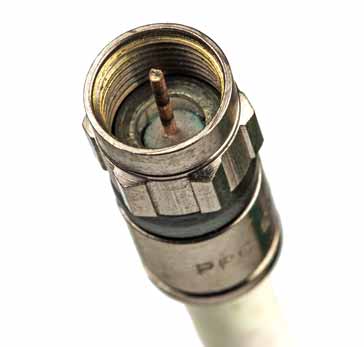F Type Connector for TV Coax Cables
The F connector or F-type connector is widely used with TV coax cables for both satellite and terrestrial TV and other applications.
Home » Electronic components » this page
RF Coax Connectors Includes:
RF connectors
RF connector specifications
BNC connector
TNC connector
N-type connector
SMA connector
SMB connector
MCX connector
Precision connectors
UHF connector
F-type
Related connector types:
Other connectors
The F connector or F-type connector is a form of coax cable connector that is widely used with domestic television equipment.The F connector is cheap and can perform to frequencies in excess of 2 GHz making it ideal for terrestrial and satellite links between antennas / down-converters or LNBs and the television itself.
In Europe, cables for down-converted satellite signals that fall between 950–2150 MHz from LNBs and DC power and block signalling from satellite receivers exclusively use F connectors.

The connector is usually used with RG-6/U cable, although it can also be used with the older RG-59/U cable.
The F type connector provides some significant improvements over the Belling Lee connectors (IEC 61169 part 2) that are widely used in Europe. These connectors were developed around 1922 and naturally their performance is not up to that of UHF TV.
F connector development
The F connector was developed in the USA in the 1950s by Eric E Winston of Jerrold Electronics, a company that was developing equipment for the domestic TV cable market.
The connector became widely adopted for VHF and then UHF television in the USA. It was cheap and performed well within domestic TV situations.
With the globalisation of TV equipment, and the wider adopting of satellite TV, the connector has come into more global use, first for satellite TV and then for terrestrial TV cables.
With its increased use it has been standardised by the International Electrotechnical Commission under its standard IEC 60169 which standardised radio frequency connectors.
F connector basics
The F type connector is an inexpensive connector that provides the required performance for many domestic TV related applications. The connector has male and female connections, uses a threaded outer to provide reliable contacts and it provides good 75Ω match for signals extending well above 1 GHz.
The thread for the F-type connector is a 3⁄8 in-32 unified extra fine (UNEF) thread. The female connector has a receptacle for the centre conductor and a barrel containing the spacing dielectric on the inside and on the outside is the thread.
The male has a captive nut with a thread on the inside and the centre pin - typically this is the centre conductor of the coax itself. The connectors are arranged so that the dielectrics of the two halves are in contact, thereby producing an almost constant impedance across the connectors. In this way, the male F connector consists of only a body, which is generally crimped onto or screwed over the cable shielding braid, and a captive nut. These do not require tight tolerances and this means costs can be controlled. Push-on versions are also available.

As virtually all cables use the male connector which is particularly low cost and relatively easy to assemble, this provides for a low cost and very effective connector solution.
The higher cost female connectors are found in the form of bulkhead connectors for use within televisions themselves, and for any couplers that may be needed.
The inner conductor of the coaxial cable is key to the design - as such the coax must have a solid centre conductor, i.e. not stranded. Also it is not water resistant. As a result, specially waterproofed versions are required for external use.
 Written by Ian Poole .
Written by Ian Poole .
Experienced electronics engineer and author.
More Electronic Components:
Batteries
Capacitors
Connectors
ADC
DAC
Diodes
FET
Inductors
Memory types
Phototransistor
Quartz crystals
Relays
Resistors
RF connectors
Switches
Surface mount technology
Thyristor
Transformers
Transistor
Unijunction
Valves / Tubes
Return to Components menu . . .



